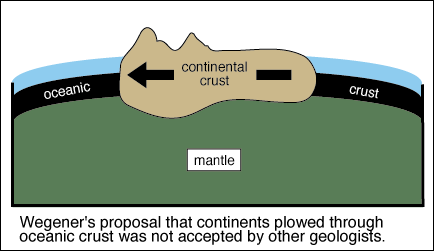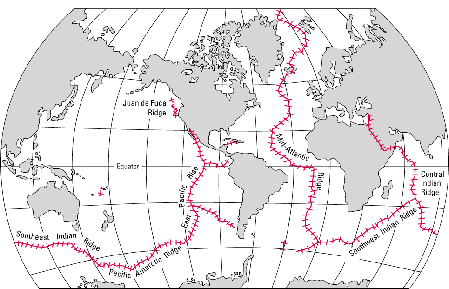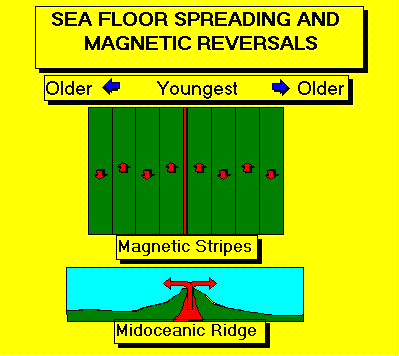The Mobile CrustWegener's ideas were not readily accepted during his day because he did not offer a plausible mechanism for the movement of the continents. Wegener suggested it was the spin of the Earth that caused plates to "plow" their way through the mantle beneath (Figure 15.9).
Figure 15.9 Wegener's proposed movement of
plates Interestingly, there appeared to be a split in the scientific community in
a geographical sense at the time. Geologists in the
Northern hemisphere were less accepting as
those living in the Southern hemisphere who were familiar with the rocks Wegener used to
support his hypothesis. It wasn't until 1928 that a Scottish geologist proposed a
mechanism to drive continental drift. Arthur Holmes
Figure 15.10 Holmes' convection current model.
Figure 15.11 Mid-ocean Ridge In the late 1950's and early 1960's oceanographic research was opening the final frontier on Earth, the mysteries of the ocean floor. During the 1950's seismologists showed that earthquake activity was concentrated along the longest continuous mountain system on Earth, the mid-ocean ridge. Known for over a century, the mid-ocean ridge system in the Atlantic Ocean rises some 6,500 feet above the surrounding ocean floor and extends for more that 37,500 miles (60,000 km) in all the world's oceans. At the crest of the ridge system lies a trough or rift. These rifts are about 20 miles wide (30 km) and 6,500 feet (2,900 m) deep and are a site where lava is expelled on to the ocean floor. The youngest material is found near the ridge with rocks of increasing age further away. It appears that the mid-ocean ridge is the site of sea floor spreading leading to plate movement. The key to sea floor spreading was found in the magnetic properties of rock lying on the sea floor.
Figure 15.12 Sea floor spreading and magnetic
stripes Geoscientists found that as new material is extruded from the mid-ocean ridge onto the ocean floor, the polarity of the rocks is frozen in time. Dragging a magnetometer across the ridge, they noticed that the polarity recorded a series of "flips" when the polarity of the rocks reversed. Parallel stripes of magnetic reversals on either side of the ridge was supporting evidence for sea floor spreading. (See animation of magnetic stripe formation - caution large file) (For more details see: North Cascades Geology - Sea Floor spreading" and Magnetic Stripes and isotope clocks (USGS). These ideas set the stage for further research that has given us a plausible explanation for the movement of the crust and the drifting of continents first proposed by Wegener.
|




